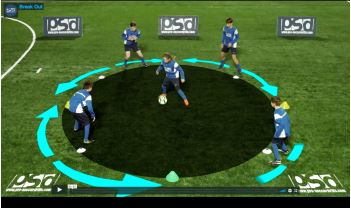Playing the 8v8 Soccer Game
Playing the 8v8 soccer game
Small-sided games are fancied by coaches as many studies show that there are so many advantages given by those. As the number of the players and the space are reduced it gives far more touches of the ball by all players so they experience more in-game situations that help their education and improvement as well. This is the reason 8v8 is not only a small-sided game but a part of the youth players’ progression system. 8v8 soccer game is usually played by U13’s children in most parts of the world because younger players wouldn’t process all the stimulus they meet through playing this kind of soccer game. This also helps the players participate more in the in-game situations so they experience all the phases of soccer in more details but gives enough room for coaches to teach tactical variations and make the players understand the 10v10 game, too, as there is only a 2-player difference between the two games. Coaches should prepare children for the 11-a-side game so they should know which 2 players (positions) to leave out when his youth players are at this stage. This will affect the system of play in the 8v8 game.
Systems of play in 8v8 soccer game
System of play is secondary to style of play. Style of play decides the principles that can be seen during soccer games. Also, there are many advantages of each systems of play as players can refer to a position during the game so their understanding will be easier. Principles don’t change but systems do, this is why we can see many formations during only one soccer game. There are options for coaches, too, to choose the best formation to teach the players.
In most of the times soccer clubs have an 11-a-side team that has an own system of play, and all the youth players are being prepared for that formation and style. This is what often determines the 8v8 formation for the youth team, so we should take a look at some examples.
The 4-1-2-1 formation
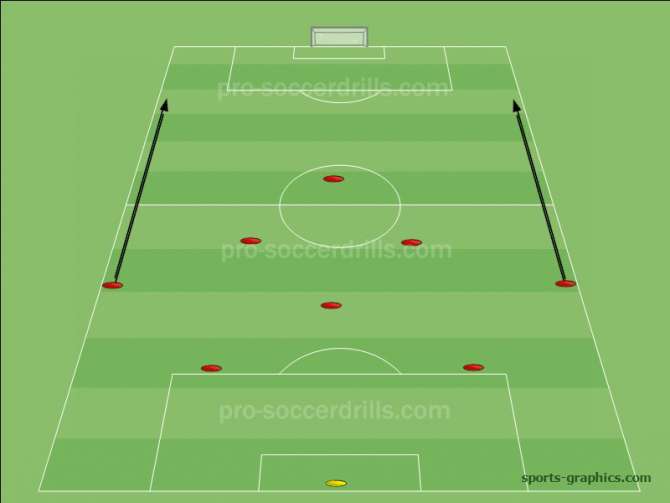
This is one of the most common formations playing the 8v8 soccer game. Only the two wide players are missing from a 4-3-3 formation. This system of play has four defenders (the back four), a holding midfielder, two attacking midfielders and a striker. As it was mentioned, there are no wide attackers or wingers so those spaces must be occupied by other players. The players that should load these empty spaces can be almost anybody depending on the actual interchanging movements and the principles of the game. Most of the times these spaces are left for the wing backs (fullbacks) as the modern soccer game demands these players to arrive there as the attack builds up. This will help the fullbacks improve their lactate-threshold capacity. Attacking midfielders can also attack these empty areas depending on the tactics.
Here is a football drill to improve the contribution of the wide players in the attacking third: 8v8 Tactical Game for Fast Break
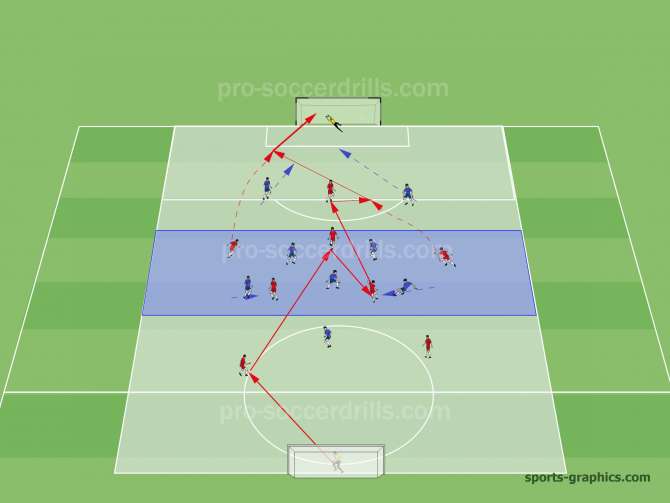
Defending can be easily organised using this formation as a rhombus (from the 4v4 game) can be found in the middle. The principles remain the same for them as before even in defence. The defending method of the back four can be the same as it will be later in the 11-a-side game.
The build-up phase looks the same in this formation as it is in the 4-3-3 in most of the times, the defending midfielder can drop between the two centre backs to create an overload, meanwhile fullbacks can go higher on the pitch. This positional build-up play is used by most of the teams nowadays. Tactically it is really flexible as coaches can drag a second defensive midfielder back easily for the overload in the defensive third where the build-up phase starts.
The 3-2-3 formation
3-2-3 gives the coach the stability, the well distributed spaces and the appropriate and clear roles for the players. There are three defenders, all can be called as centre backs, there are two organiser midfielders that are called central midfielders and there are three attackers: a striker and two wingers. This formation doesn’t differ that much from the 4-1-2-1: the wide spaces are occupied by the wing players while the two centre backs split up and another player (holding midfielder in the previous formation) steps back.
There’s a great soccer drill for this to coach: Building Attack from Back in 4-3-3 Formation
Formations and exact positions give basic points for the youth players on the pitch. The two wingers should defend as well and need to take part in the build-up phase as well as the finishing phase.
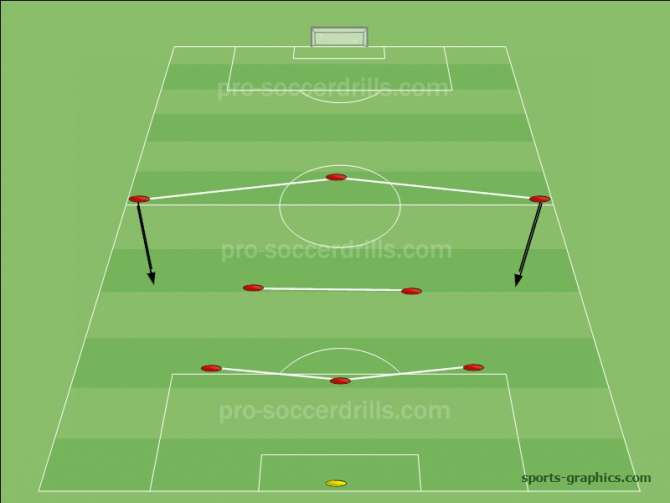
In this formations the two midfielders should outrun the opponent as they have to help the striker and then get back in defence, too. These players should be the most intelligent players in the team, they need to communicate, make quick decisions and be the play-makers. As it comes from the name 3-2-3, there are only 3 lines (defenders, midfielders and attackers), so the two in the middle have to take care of the team’s length. If the team is too long, it is easy to outplay them with many passes, this is why defending (including the attack to defence transition) is harder for coaches to teach.
The build-up phase can remain the same, two of the three centre backs separate and one stays in the central zone to exploit. One of the midfielders can be dragged back and also midfielders can interchange positions with the attackers.
The 3-1-3-1 formation
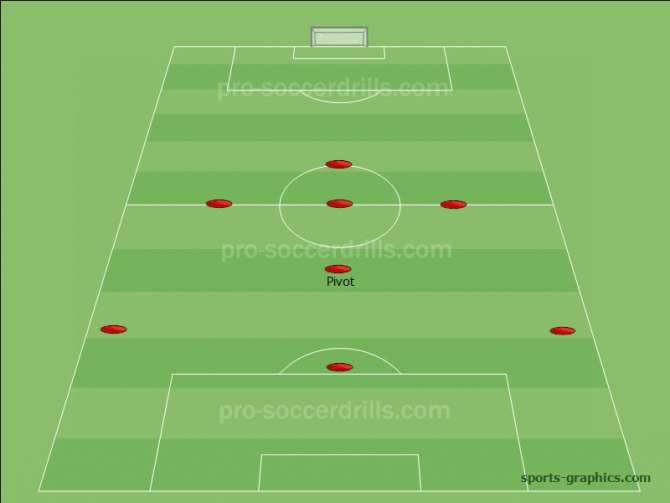
This formation is the easiest to teach as there are 2 of the 3-1 formations on the pitch. The movements are quite the same so it is quite simple to organize mostly in defence. There are only 3 to 4 players to help the build-up phase so it is better for a long-passing style of play rather than the short-passing style that loves to keep possession of the ball. There are three center backs, a holding midfielder, three attacking midfielders and a striker.
The holding midfielder (pivot) has such a hard task as he needs to connect the attacking midfield with the defenders in attack and defence, too. He needs to pick up the second balls and need to pick up the striker stepping back. He should be a good communicator on the pitch, because he needs to lead 4 players in the front of him. So not only should he be a leader, he needs to understand the game in each detail. He usually is the cover player in the triangles that players often make.
You can read about triangles and roles in this blog post: The Importance of Triangle in Soccer
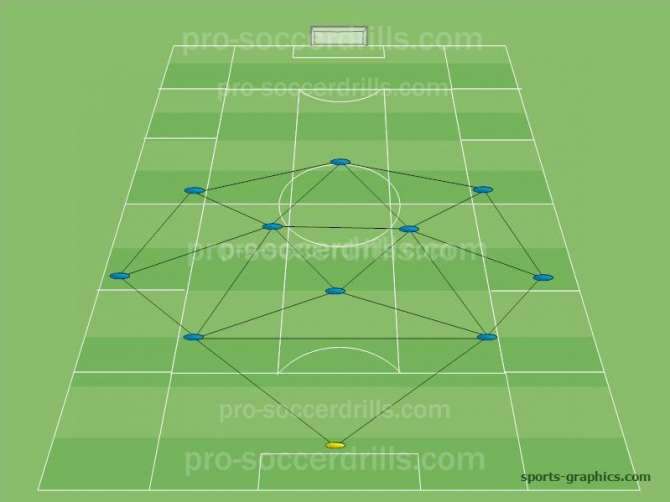
The wingers should be able to accommodate to the transitions quickly, too, as they need to open up the pitch in width as soon as possible.
The drills coaching this formation are easier to organize, the task of the four lines (3-1-3-1) are quite similar. Using this formation in a youth team will be great for a back three in the 11-a-side game.
8v8 soccer game for adults
There are many other advantages of the 8v8 game even for elder or adult soccer players. Not only can coaches teach tactical movements and organisation but they can use this as a small-sided game to improve physical abilities like the heart rate maximum (HRmax). There were several studies that tried 8v8 in different areas. These studies were to analyse the average HRmax% effect of the SSG. They found out that 8v8 is best to play in a 70x45m sized area for adults for 4x8 minutes with a rest time of 90 seconds. The players in average reached a 88,3% of their HRmax which was the best result during the test only analysing this aspect.
Summary
8v8 gives many advantages for coaches. Not many teams are able to play 11-a-side at the end of the training sessions because of the number of the players in the squad. Apart from the 11v11 game, 8v8 is one of the best because it maintains symmetry and also can be coached pretty decently. There are more formations of course it depends on the coaches’ needs. As the space is often reduced, players can be coached more emphasizing a selected movement, rotation (interchange) or phase.
Small-sided games help players learn how to be compact, how to communicate better and how to be more useful in every in-game situations even without the ball. They experience principles and then repeat it over and over. These will help to accommodate to the coaches’ strategic ideas.
Free Trial
GET YOUR FREE 14 - DAYS TRIAL NOW! INCLUDING:




